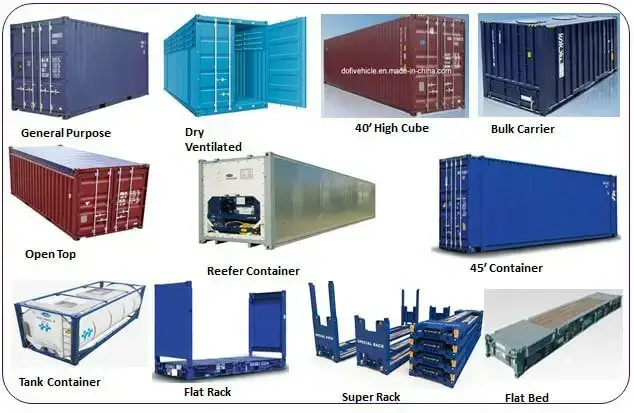Want to understand how to build a storm shelter out of an intermodal shipping container? We understand that living in areas prone to severe weather can be daunting, but having a storm shelter can provide essential protection and peace of mind for you and your loved ones.
When it comes to constructing a storm shelter, using shipping containers offers numerous advantages that make them a popular choice.
Importance of Storm Shelters in Areas Prone to Severe Weather
Severe weather, such as hurricanes, tornadoes, or even strong thunderstorms, can cause significant damage to homes and pose a threat to life. To ensure maximum safety, having a designated storm shelter is crucial.
Storm shelters are specifically designed to withstand the destructive forces of severe weather, protecting you and your family from potential harm.
Advantages of Using Shipping Containers for Building Storm Shelters
Shipping containers, with their robust construction and structural integrity, offer unparalleled advantages for building storm shelters:
- Durability: Shipping containers are built to withstand extreme conditions, making them perfect for storm shelters.
- Cost-efficiency: Compared to other building materials, using shipping containers can be a cost-effective solution for creating a secure shelter.
- Easy customization: Shipping containers can be easily modified and adapted to meet specific shelter requirements, allowing for flexibility in design and size.
- Quick setup: Utilizing shipping containers for storm shelters can significantly reduce construction time, providing quicker access to a safe haven.
- Portability: If you ever need to relocate, shipping container storm shelters offer the advantage of being easily transportable.
When it comes to building a storm shelter, using a shipping container combines functionality, affordability, and durability to provide optimal protection in times of severe weather.
Table of Contents
Understanding Shipping Containers

A. Overview of Shipping Containers
Shipping containers are widely used for transporting goods across the globe. They are sturdy, standardized metal boxes designed to withstand the rigors of long journeys at sea. These containers play a vital role in international trade, ensuring goods are securely transported from one location to another.
1. Definition and purpose: A shipping container is a large, rectangular metal container used for shipping goods.
2. Sizes and dimensions available: Shipping containers come in various sizes and dimensions to accommodate different types and quantities of cargo. The most common sizes are 20 feet and 40 feet in length, with a standard width of 8 feet and a height of 8.5 feet.
3. Types of containers: There are different types of shipping containers available, including standard containers, high cube containers (taller than standard), refrigerated containers (for temperature-sensitive goods), and more.
Read More on Shipping Container Home in Kansas City: Modern Housing Solution
B. Assessing the Suitability of Shipping Containers for Storm Shelters
When considering using a shipping container as a storm shelter, it’s essential to assess its suitability for the purpose.
1. Strength and durability: Shipping containers are built to withstand the harsh conditions of marine transportation, making them inherently strong and durable. Their steel structure provides a solid foundation for a storm shelter.
2. Water and wind resistance: Due to their watertight design, shipping containers offer protection against water intrusion. Additionally, their sturdy construction makes them resistant to high winds often associated with storms and tornadoes.
3. Accessibility and ventilation: Before using a shipping container as a storm shelter, it’s important to ensure proper accessibility and ventilation to create a safe environment. Adequate ventilation systems and secure entry points should be established.
- 62 oz. dehumidifier with auto shut off and sleep mode to maximize efficiency.
- Suitable for a 950 square foot space, perfect for bedroom, basement, home or RV.
- Ultra-quiet operates at under 39dB- Quiet operation.
- Lightweight and portable, easy to move and store.
- 24 hour auto shut off timer and continuous drainage system.
- Easy-to-use control panel and LCD digital display.
- Filter can be easily cleaned to reduce bacteria build-up.
- Removable tank for convenient emptying and water-level indicator for easy monitoring.
- Empty water-tank warning for convenience and safety.
- Energy efficient to save on your electricity costs.
Read More on What Is The Best Way to Ventilate A Shipping Container?
Preparing the Ground
A. Selecting an Appropriate Location for the Storm Shelter
When choosing a location for your storm shelter, it is crucial to consider a few factors. Firstly, make sure the spot is easily accessible to all family members.
Secondly, select an area that is not prone to flooding or standing water. It’s also important to avoid areas with potential hazards such as underground utilities or tree roots. Lastly, ensure that the location meets any local codes or regulations that may apply.
B. Necessary Ground Preparation Steps

Before starting the installation of your shipping container storm shelter, it’s essential to undertake necessary ground preparation steps. These steps will help ensure the stability and durability of your shelter:
- Clearing the area: Remove any debris, rocks, or vegetation that might interfere with the placement of your storm shelter. This will also help to create a clean working environment.
- Leveling the ground: Ensure that the ground where the shelter will be installed is level. Use a shovel or a rake to smooth out any uneven areas and create a flat surface.
- Adding foundation supports if required: Depending on the condition of the ground and the specific requirements of your storm shelter, you may need to add foundation supports. This could involve pouring concrete footings or setting up support beams or piers.
Read More on Shipping Container Home Companies: Expert Guide
Storm Shelter Design and Construction
A. Design Considerations
When constructing a storm shelter using a shipping container, there are several design considerations to keep in mind:
- Determining the size and capacity of the storm shelter: Before beginning the construction process, it is crucial to assess the number of people who will be using the shelter and how much space will be required.
- Planning the layout for maximum functionality: Carefully plan the interior layout to ensure that all necessary supplies and equipment can be easily accessed during an emergency.
- Ensuring safety standards: Emergency exits and proper ventilation are vital for a storm shelter. Make sure to include these elements in the design to ensure the safety of those inside.
B. Steps for Building a Storm Shelter Using a Shipping Container
To build a storm shelter using a shipping container, follow these steps:
- Acquiring a suitable shipping container: Look for a container that meets your required size and quality standards.
- Preparing the container for installation: Clean the container thoroughly and remove any unwanted components such as doors or windows.
- Reinforcing the container for added strength: Strengthen the container’s structure by adding steel reinforcements or additional supports.
- Cutting openings for windows and ventilation: Create openings for windows and ventilation systems to ensure proper airflow and visibility.
- Implementing insulation against extreme weather conditions: Install insulation materials to maintain comfortable temperatures inside the shelter during extreme weather.
- Reinforcing the flooring for durability: Strengthen the floor of the container to withstand stress and potential impacts.
- Securing the container to the ground or foundation: Anchor the container securely to the ground or foundation to prevent it from shifting during storms.
Read More on Shipping Container Anchors: 10 Of The Best Anchors!
Installing the Storm Shelter

A. Excavation and Assembly Process
Before you can install the storm shelter, you’ll need to go through the excavation and assembly process.
1. Excavating the Hole for the Container
The first step is to excavate a hole that is large enough to accommodate the shipping container. Make sure you follow the recommended dimensions to ensure the shelter fits securely.
2. Lowering the Container Into the Hole
Once the hole is ready, carefully lower the shipping container into it. You may need the assistance of a crane or heavy machinery to safely maneuver the container into position.
3. Leveling and Securing the Container
After the container is in place, ensure it is level and secure within the hole. Use appropriate bracing and supports to prevent any movement or shifting during storms or high winds.
Read More on Building a Container Home in Colorado: Unique Housing Solution
B. Finishing Touches and Additional Features
1. Fitting a Certified Storm Shelter Door
It is crucial to install a certified storm shelter door that meets safety standards. This door will provide a secure seal during storms and ensure the shelter remains safe and waterproof.
2. Adding Emergency Supplies Storage
Consider adding storage shelves or cabinets within the storm shelter to store emergency supplies. This will ensure you have essential items such as food, water, first aid kits, and other necessary supplies readily available during an emergency.
3. Electricity and Lighting Installation
For added convenience and safety, you can install electricity and lighting inside the storm shelter. This will provide illumination during power outages and make the shelter more comfortable.
Tornadoes and Storms: Safety Guidelines
In order to ensure the safety of yourself and your loved ones during a tornado or other severe storm, it is important to follow some essential safety guidelines:
A. Understanding Tornadoes and Their Impact on Structures
Before constructing your storm shelter, it is essential to understand the destructive force of tornadoes and their impact on structures.
Tornadoes are powerful rotating columns of air that can cause extensive damage, including ripping apart walls and roofs. Therefore, it is crucial to build a storm shelter capable of withstanding high winds and debris.
B. Educating About Storm Preparedness and Early Warnings
Being prepared can save lives during a storm. Educate yourself and your family about storm preparedness, including identifying a safe location in your home or seeking immediate shelter in a storm shelter.
Additionally, stay updated with weather forecasts and pay attention to early warnings issued by local authorities to ensure timely response.
C. Emergency Protocols and Procedures for Storm Shelters
Having well-defined emergency protocols is crucial in ensuring the safety of everyone using the storm shelter.
Create a comprehensive plan that includes procedures for entering the shelter, communication protocols, and emergency supplies. Regularly practice these protocols with your family so that everyone knows what to do in case of a storm.
In conclusion, by understanding tornadoes and their destructive force, educating yourself and your family about storm preparedness, and establishing emergency protocols for your storm shelter, you can ensure your safety during severe storms. Remember, safety should always be your top priority!
Read More on Building A Container Home In Massachusetts: A Modern Solution
Benefits of Shipping Container Storm Shelters
In times of severe weather conditions, having a storm shelter can provide a safe haven for you and your loved ones. When it comes to storm shelters, shipping containers offer several advantages that make them a popular choice.
A. Cost-effectiveness Compared to Traditional Storm Shelters
One of the biggest advantages of using a shipping container for your storm shelter is the cost-effectiveness. Traditional storm shelters can be quite expensive to build, especially if you want a customized design.
On the other hand, shipping containers are readily available and can be purchased at a fraction of the cost. With some modifications and additions, you can easily transform a shipping container into a secure and dependable storm shelter.
B. Portability and Versatility of Shipping Container Shelters
Another benefit of using shipping containers for storm shelters is their portability and versatility. Unlike traditional storm shelters, which are typically built into the ground, shipping container shelters can be easily moved or relocated if needed.
This flexibility allows you to adapt to changing circumstances or even transport your shelter to a different location if you decide to move. Additionally, the design options for shipping container shelters are endless, giving you the freedom to customize the interior and exterior to fit your specific needs.
C. Durability and Resistance to Extreme Weather Conditions
Shipping containers are built to withstand the most demanding conditions, making them an excellent choice for storm shelters. These containers are constructed from high-strength steel, which provides exceptional durability and resistance to extreme weather, including strong winds and heavy debris.
Additionally, shipping containers are designed to be watertight, ensuring that you and your loved ones stay safe and dry during a storm.
Overall, using a shipping container as a storm shelter offers cost-effectiveness, portability, versatility, and durability, making it a reliable option to protect against severe weather events.
Read More on Building Inspection Adelaide: Ensuring Safety and Quality
Storm Shelter Regulations and Legal Considerations
A. Researching Local Building Codes and Regulations
Before starting the construction of a storm shelter using shipping containers, it is crucial to research and understand the local building codes and regulations in your area.
Different regions may have specific requirements regarding storm shelters, such as size, materials, and location. By familiarizing yourself with these regulations, you can ensure that your project meets all necessary standards and avoid any legal issues.
B. Permits and Inspections Required for Building Storm Shelters
In many jurisdictions, building permits and inspections are mandatory for constructing storm shelters. These permits ensure that the structural integrity and safety features of the shelter are up to code.
Contact your local building department to obtain the necessary permits and schedule inspections at various stages of the construction process.
Adhering to these requirements will not only keep you in compliance with the law but also provide peace of mind knowing that your storm shelter is built to withstand severe weather conditions.
Read More on Building A Shipping Container Home In Germany: Good or Bad?
C. Seeking Professional Advice and Assistance if Necessary
Building a storm shelter using a shipping container can be a complex task, especially when it comes to meeting regulations and legal considerations.
It is advisable to seek professional advice and assistance if you are unfamiliar with local building codes or lack the necessary expertise.
Consulting with architects, engineers, or contractors experienced in constructing storm shelters will ensure that your project meets all legal requirements and is designed to provide the highest level of protection.
Alternative Uses for Shipping Containers
Shipping containers are not only ideal for creating storm shelters, but they also have numerous alternative uses. Let’s explore some creative DIY projects and sustainable housing solutions using shipping containers.
A. Exploring Other Creative DIY Projects Using Shipping Containers
Aside from storm shelters, shipping containers can be repurposed into a wide range of innovative DIY projects. Their sturdy structure and transportability make them perfect for creating:
- Backyard sheds or workshops
- Outdoor kitchens or bars
- Guest houses or Airbnb rentals
- Swimming pools
- Greenhouses or gardening spaces
- Art studios or creative spaces
- Pop-up retail shops or cafes
The possibilities are endless when it comes to transforming a shipping container into a unique and functional space. With some creativity and basic construction skills, you can turn an ordinary container into something extraordinary.
B. Sustainable Housing Solutions with Shipping Containers
Shipping containers also offer a sustainable and affordable solution for housing. With the rising cost of traditional construction materials and the need for environmentally friendly alternatives, more people are turning to shipping containers for residential purposes.
These containers can be easily transformed into beautiful, energy-efficient homes that are both stylish and sustainable. By repurposing containers, we can reduce waste and minimize the demand for new construction materials.
Not only are shipping container homes environmentally friendly, but they are also cost-effective. The affordability of shipping containers makes them an accessible option for individuals looking to build their own homes within a reasonable budget.
Furthermore, these homes can easily be modified and expanded, offering flexibility as your living needs change over time. Whether you’re looking for a tiny house or a spacious family home, shipping containers can be customized to fit your specific requirements.
By embracing the concept of repurposing and recycling, shipping containers have opened up a whole new world of sustainable and affordable housing possibilities.
Read More on The Importance of Site Surveys in Construction: Expert Advice
Conclusion
Ensuring the safety of you and your loved ones during severe storms is crucial. Building a storm shelter provides a reliable and secure space to seek protection when tornadoes strike.
Throughout this guide, we have explored the various aspects of building a storm shelter out of a shipping container. From understanding shipping containers and preparing the ground to designing and constructing the shelter, we have covered it all.
Additionally, we have discussed the installation process, safety guidelines, and the benefits of using shipping containers for storm shelters.
By considering a shipping container for your storm shelter, you not only enhance your safety but also contribute to sustainable and eco-friendly development practices. Recycling and repurposing shipping containers not only provide a cost-effective option but also reduce waste and promote a greener future.
As you plan and embark on your own storm shelter project, it is important to stay informed and comply with storm shelter regulations and legal considerations in your locality. Always consult with local authorities and professionals to ensure your shelter meets all necessary standards.
If you are looking for alternative uses for shipping containers, beyond storm shelters, the possibilities are endless. Shipping containers can be transformed into offices, shops, homes, and even art installations. Embrace the versatility and creativity offered by shipping containers and explore the countless opportunities they present.
Further Guidance
Remember, building a storm shelter is a responsible decision that can save lives. Don’t wait until it’s too late to take action. Consider constructing your own storm shelter using shipping containers and prioritize your safety and the safety of those around you.
For further guidance and resources on building storm shelters out of shipping containers, please refer to the following:
- Building a Storm Shelter: An In-depth Guide – A comprehensive step-by-step guide on building a storm shelter using shipping containers.
- Local Building Codes and Regulations – Ensure that you adhere to the specific regulations in your area.
- Professional Consultation – Seek advice from experts in the field to ensure the structural integrity and safety of your storm shelter.
- Local Disaster Preparedness Resources – Familiarize yourself with the local resources available to support your disaster preparedness efforts.
Building a storm shelter out of a shipping container is a tangible way to protect yourself from the destructive forces of nature. Don’t delay, start planning and building your storm shelter today!
Read More on Why Building Inspections in Queensland are Crucial: Expert Guide


